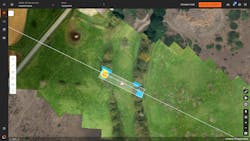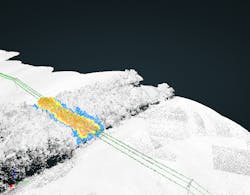When vegetation isn’t managed properly, trees grow or fall onto power lines. Not only does the obvious outage occur, but consumers can be put in harm’s way, and utilities can face large fines, which just add to the cost associated with this challenge.
According to the Federal Energy Regulatory Commission (FERC), vegetation management, particularly trees that grow or fall into overhead power lines, is the single largest cause of electric power outages. The agency also states that tree and power line conflicts have caused significant wildland fires in both the United States and Canada. Two key recommendations presented by FERC are to improve current systems for managing utility vegetation management (UVM) workload and schedules and adopt consistent and industry-accepted best practices for UVM.
Vegetation Management Today
The primary purpose of vegetation management is managing encroachment on power lines. These encroachment rules are generally driven by FERC for transmission and by local regulatory bodies for distribution lines. Encroachment rules can be further delineated by asset or voltage type. Additional concerns are unique to each utility, such as species identification, growth modeling and vegetation height and volume estimation.
Traditional vegetation management systems rely on manual inspection of assets to assess which trees need attention, usually on a quarterly basis. Because the grid is expansive, it is nearly impossible to have a view into all areas that need trimming with this traditional approach.
The blackout that happened in the northeast United States in 2003 is a good example of the scale of the impact mismanaged vegetation can have on the grid. The outage affected an estimated 55 million people and caused significant long-term economic loss. According to FERC, the outages were caused by conflicts between high-voltage transmission lines and vegetation. The agency concluded that “had these specific trees been pruned or removed before these outages, the blackout most likely would not have occurred.”
To mitigate these threats, FERC standard FAC-003-4 Transmission Vegetation Management addresses the minimum requirements to reduce vegetation encroachment to “prevent the risk of those vegetation outages that could lead to cascading [circuit failures.” Fines of up to US$ 1 million per violation per day are possible for FAC-003 violations.
While there have been no cascading failures like the 2003 blackout since the implementation of the FERC guidelines for UVM, major UVM-related outages have still occurred. For example, one major western utility failed to comply with state vegetation management laws protecting its bulk transmission corridors resulting in more than 20 wildfires burning half a million acres. The utility paid regulatory fines of $2.1 billion and settled civil claims for more than $25 billion.
Electric utilities have a clear understanding that legacy vegetation management systems are outdated, too costly and ineffective. Many UVM programs rely heavily on visual inspections where they largely depend on ground crews and local intelligence. Utilities that use this tactic understand that this is a weakness, but they aren’t ready to reduce dependency on local ground inspections.
Today, vegetation management requires countless hours to survey and gather data before countless more hours are spent clearing all the hot spots. There is a better, safer, more efficient and cost-effective way to scale vegetation management.
Data Collection = intelligence
Utilities universally agree UVM is vital to preventing outages, but it represents one of their most significant recurring maintenance expenses. The cost of new technology that would improve field intelligence must be justified by cost savings derived from the UVM program. Further, large utilities with longer transmission lines recognize the value of automation and advanced analytics, while relatively smaller utilities with smaller budgets may have difficulty justifying the cost.
Many large utilities report budgetary constraints brought on by the recent pandemic. Additionally, many utilities are not currently using advanced analytics beyond internal systems as a part of their UVM program. For example, Light Detection and Ranging (LiDAR) is used sparingly for vegetation clearance limits and line sage, and LiDAR alone cannot provide species identification and growth rates based on weather conditions and precipitation rates.
And those using LiDAR are the relatively larger utilities. The cost, however, remains prohibitive for large geographic areas, especially those that require frequent inspections. However, the cost is decreasing, which will lead to better access to data.
Current systems lack many insights needed for proper management of the grid’s vegetation such as weather’s effect on growth, specific growth patterns of tree species and additional factors which could play a role in outages, such as buildings and other structures. And if there were systems that could be predictive—while being more efficient—utilities would line up at the door.
If utilities could choose which data collection technologies they want in automation solutions, they would include:
- Weather pattern prediction and its impact on vegetation growth
- Real-time wind and fire risk identification and its impact on growth rates
- Identification of tree species with growth rates and patterns
- The predictive impact of vegetation growth retardants
Here’s where software comes in. Analytics provided by AI and machine learning techniques can combine weather and precipitation forecasts, obtain quality imagery of large tree canopies above transmission wires and expand data collection beyond trees and vegetation. AI-based vegetation management involves two components: data capture and analytics. The potential value is derived by using data-driven visual images captured by many different sources (drones, fixed-wing, helicopters, satellites, humans and sensors) to drive vegetation management decisions.
Global T&D utilities must invest in data analytics to facilitate reduced forced outages and to minimize the probability of catastrophic events such as fires and major regional outages. Sources estimate that large utilities each pay more than $100 million for vegetation management programs each year. California utilities alone pay a combined total of more than $1 billion a year on vegetation management.
Accenture analysts estimate that utilities spend “around $6 billion to $8 billion annually on clearing vegetation from overhead lines.” An IDC Research3 survey found that for a third of respondents, the cost of a typical T&D outage exceeds US$ 100,000. However, the cost of an outage can escalate into the millions of dollars per hour. In fact, the Department of Energy has estimated that outages can cost the U.S. economy US$ 150 billion annually.
The cost of vegetation management is staggering and continues to grow each year. Containing the rising cost of vegetation management activities involves:
- Data-driven visual intelligence supported by analytics
- Support for all major visual inspection file types
- Improving GIS network accuracy with AI-driven updates
- A shared database for vegetation management and asset inspection
Data-driven visual intelligence can significantly reduce vegetation management costs by up to 20% and tree-caused unplanned outages by up to 30%. The result of a singular platform for vegetation management and asset inspection functions can offer up to a 90% reduction in the cost of data management and integration.
Reducing risk exposure for T&D utilities and their customers by detecting early and mitigating a single catastrophic failure cannot be reduced to mere dollars and cents. For many utilities, a miscalculation will be measured in billions of dollars and never-ending regulatory scrutiny. There is also intangible damage done to its reputation and customer goodwill.
Demonstrating Value
The following business case study demonstrates the potential economic value generated by using data-driven analysis to drive vegetation management decisions based on an assumption of status quo versus an analytics-driven approach to vegetation management.
In this case, we are taking a two-step approach:
- Move from an annual rotational trimming strategy (generally over four years with 25% of the territory trimmed per year) to a purely risk-based approach that identifies and categorizes overgrowth encroachment risk across the entire region. This drives the highest priority trimming in the current year.
- Move from a distance-based vendor payment model to a volume-based model. This approach shifts payments from miles/kilometers covered to actual acres trimmed.
The case study includes several assumptions:
- The utility services 1000 miles of power lines or 15,168 acres.
- Clearance around the power lines is expected to be 125 ft. on both sides of the lines.
- All images have been previously captured and those costs are included in the analysis.
Generally, data-driven vegetation management involves data capture, vegetation management analytics and asset inspection analytics. This use case focuses on data capture and vegetation management analytics only. An initial $100,000 investment in software-driven data analytics returns US$ 74,053 in savings to the user, for an ROI of 74.1%.
A human-guided artificial intelligence-powered predictive model enables utilities to more effectively and efficiently handle vegetation management and save on manpower while spending less overall. Ultimately, software can reduce outages by 30% and vegetation management costs by up to 20%.
In addition, using drones, satellites, LiDAR, big data analytics for smart grid and AI-driven technology, which moves away from a time-based trimming approach to a risk-based one, allows utilities to more efficiently focus on the problem areas. The software can analyze the data and images and give a trained system manager a holistic view of the entire area and provide predictions on where to focus next.
When looking at how this risk-based approach affects the bottom line, the results are eye-opening:
- 51% cost reduction per acre of mechanical trimming
- 30% cost reduction on volume trimming
- 30% reduction of actual trimming work
Vegetation management is a critical and expensive maintenance responsibility to protect transmission and distribution infrastructure. But, done the right way, it can ultimately save money in outage losses and improve the safety of consumers.
About the Author
Brian E. Hoff
Brian E. Hoff is executive of grid software innovation solutions for GE Digital. In this role, he leads the product management strategy for the analytics portfolio and is focused on co-innovation with customers and developing customizable solutions to help electric utilities meet their energy transformation goals. Hoff has more than 27 years of experience in the energy industry serving in a variety of roles in nuclear, corporate services, engineering, information technology, cybersecurity and emerging technology, including launching new business ventures as the vice president of innovation at Exelon Corp. He graduated from Hamilton Technical College with a bachelor’s degree in electronics engineering technology and earned an MBA degree from the University of Phoenix. Additionally, he has completed Northwestern University’s Kellogg School of Management’s global advanced management program.





